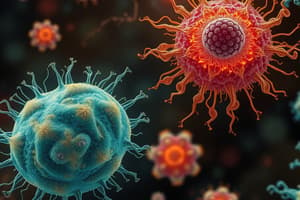Podcast
Questions and Answers
Prokaryotic cells do not have a defined ______.
Prokaryotic cells do not have a defined ______.
nucleus
Cell ______ refers to the process by which cells become specialized.
Cell ______ refers to the process by which cells become specialized.
differentiation
Microvilli are examples of cell ______ that help with absorption.
Microvilli are examples of cell ______ that help with absorption.
modifications
Eukaryotic cells can be classified into various types such as ______ and animal tissues.
Eukaryotic cells can be classified into various types such as ______ and animal tissues.
The ______ in amoeba helps in movement and capturing prey.
The ______ in amoeba helps in movement and capturing prey.
Flashcards are hidden until you start studying
Study Notes
Prokaryotic and Eukaryotic Cells
- Prokaryotic cells lack a nucleus and membrane-bound organelles, while eukaryotic cells have both.
- Prokaryotic cells are typically smaller and simpler in structure compared to eukaryotic cells.
- Common examples of prokaryotic cells include bacteria and archaea, whereas eukaryotic cells include plants, animals, fungi, and protists.
Cell Differentiation, Specialization, and Modifications
- Cell differentiation refers to the process whereby a cell becomes specialized in structure and function.
- Specialization allows cells to perform unique roles, enhancing efficiency in multicellular organisms.
- Cell modifications, such as microvilli and root hairs, adapt cells for specific functions:
- Microvilli increase surface area for absorption in intestinal cells.
- Root hairs enhance water and nutrient uptake in plant roots.
Classification of Cell Types
-
Plant tissues include:
- Parenchyma: Involved in storage, photosynthesis, and tissue repair.
- Collenchyma: Provides support and flexibility in young stems and leaves.
- Sclerenchyma: Offers rigid support due to thickened cell walls.
-
Animal tissues include:
- Epithelial tissue: Covers body surfaces and lines cavities; functions in protection and absorption.
- Muscular tissue: Responsible for movement; includes skeletal, cardiac, and smooth muscle types.
- Nervous tissue: Composed of neurons and glial cells; responsible for signal transmission and communication.
Adaptations through Modifications
- Adaptations enable cells to thrive in specific environments or fulfill unique roles within an organism.
- Structures such as pseudopods in amoeba facilitate movement and prey capture, showcasing the diversity of adaptations across different cell types.
Studying That Suits You
Use AI to generate personalized quizzes and flashcards to suit your learning preferences.




